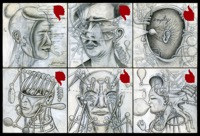Personality disorder
Definition
A deeply ingrained and maladaptive pattern of behavior of a specified kind, typically manifest by the time one reaches adolescence and causing long-term difficulties in personal relationships or in functioning in society.
Description
Personality disorders are a class of mental disorders characterized by enduring maladaptive patterns of behavior, cognition, and inner experience, exhibited across many contexts and deviating markedly from those accepted by the individual's culture. These patterns develop early, are inflexible, and are associated with significant distress or disability. The definitions may vary somewhat, according to source.
Official criteria for diagnosing personality disorders are listed in the Diagnostic and Statistical Manual of Mental Disorders, published by the American Psychiatric Association, and in the mental and behavioral disorders section of the International Statistical Classification of Diseases and Related Health Problems, published by the World Health Organization. The DSM-5 published in 2013 now lists personality disorders in exactly the same way as other mental disorders, rather than on a separate 'axis' as previously.
Personality, defined psychologically, is the set of enduring behavioral and mental traits that distinguish human beings. Hence, personality disorders are defined by experiences and behaviors that differ from societal norms and expectations. Those diagnosed with a personality disorder may experience difficulties in cognition, emotiveness, interpersonal functioning, or control of impulses. In general, personality disorders are diagnosed in 40–60 percent of psychiatric patients, making them the most frequent of all psychiatric diagnoses.
These behavioral patterns in personality disorders are typically associated with substantial disturbances in some behavioral tendencies of an individual, usually involving several areas of the personality, and are nearly always associated with considerable personal and social disruption. A person is classified as having a personality disorder if their abnormalities of behavior impair their social or occupational functioning. Additionally, personality disorders are inflexible and pervasive across many situations, due in large part to the fact that such behavior may be ego-syntonic (i.e. the patterns are consistent with the ego integrity of the individual) and are, therefore, perceived to be appropriate by that individual. This behavior can result in maladaptive coping skills, which may lead to personal problems that induce extreme anxiety, distress, or depression. These patterns of behavior typically are recognized in adolescence and the beginning of adulthood and, in some unusual instances, childhood.
Many issues occur with classifying a personality disorder. There are many categories of definition, some mild and some extreme. Because the theory and diagnosis of personality disorders occur within prevailing cultural expectations, their validity is contested by some experts on the basis of invariable subjectivity. They argue that the theory and diagnosis of personality disorders are based strictly on social, or even sociopolitical and economic considerations.[1]
